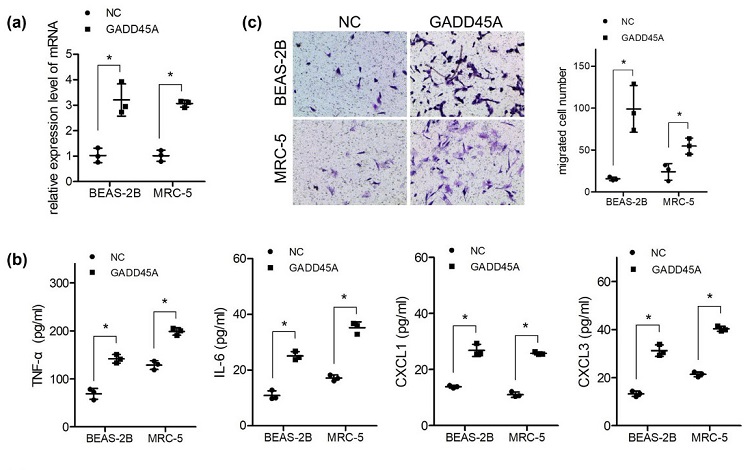COVID-19 News: Study Uncovers How SARS-CoV-2 Spike Proteins Causes Inflammatory And EMT Mechanisms In Lung Cells Via GADD45A Upregulation
Nikhil Prasad Fact checked by:Thailand Medical News Team Dec 01, 2023 2 years, 3 weeks, 2 days, 10 hours, 20 minutes ago
COVID-19 News: The global impact of the COVID-19 pandemic caused by Severe Acute Respiratory Syndrome Coronavirus 2 (SARS-CoV-2) has spurred extensive research to comprehend the intricate pathogenesis of the virus. A groundbreaking study covered in this
COVID-19 News report, conducted at the Children's Hospital of Fudan University in Shanghai, China, delves into the specific interplay between the SARS-CoV-2 spike protein and lung cells, shedding light on the induction of inflammation and epithelial-mesenchymal transition (EMT). The study focuses on two crucial cell types, namely lung epithelial cells (BEAS-2B) and fibroblasts (MRC-5), with the aim of understanding the molecular mechanisms at play, particularly the upregulation of the growth arrest and DNA damage-inducible gene alpha (GADD45A).
 Overexpression of GADD45A promoted inflammatory molecule secretion and EMT of lung cells. (a) Cells were transfected with GADD45A overexpression vector, and qPCR was performed to detect the transfection effect (n = 3). After cells overexpressed with GADD45A, (b) ELISA was used to analyze the supernatant levels of TNF-α, IL-6, CXCL1, and CXCL2 (n = 3). (c) Transwell assay was performed to detect migration ability (n = 3).
Background
Overexpression of GADD45A promoted inflammatory molecule secretion and EMT of lung cells. (a) Cells were transfected with GADD45A overexpression vector, and qPCR was performed to detect the transfection effect (n = 3). After cells overexpressed with GADD45A, (b) ELISA was used to analyze the supernatant levels of TNF-α, IL-6, CXCL1, and CXCL2 (n = 3). (c) Transwell assay was performed to detect migration ability (n = 3).
Background
With over 720 million confirmed cases and 7 million deaths globally, COVID-19 manifests in varying severity, prompting a closer examination of the molecular processes initiated by the SARS-CoV-2 spike protein. This study emphasizes the critical role of understanding these processes in lung cells with low expression of angiotensin-converting enzyme 2 (ACE2), shifting the focus from ACE2-expressing cells to non-alveolar type II (AT2) cells. Previous research has indicated the involvement of the S protein in the production of chemokines in non-AT2 cells, suggesting its role in inflammation independent of ACE2.
Methods
To investigate the impact of the SARS-CoV-2 spike protein on lung cells, researchers treated lung epithelial cells (BEAS-2B) and fibroblasts (MRC-5) with varying concentrations of the spike protein. Employing a range of assays, including enzyme-linked immunosorbent assay (ELISA), Transwell, and western blot assays, the study sought to detect inflammatory and EMT phenotypes. Additionally, RNA-sequence and bioinformatic analyses were performed to identify dysregulated genes, leading to the identification of GADD45A as a central player in the observed processes.
Results
The study revealed that treatment with the spike protein induced a significant increase in levels of inflammatory markers (IL-6, TNF-α, CXCL1, CXCL3) and triggered EMT in the examined lung cell lines. RNA-sequence analysis identified an impressive 4,238 dysregulated genes, with 18 candidate genes implicated in both inflammation and EMT processes. Notably, GADD45A exhibited the highest verified fold change, and its overexpression further promoted cytokine secretion and EMT in lung cells.
Discussion
The findings underscore the multifaceted impact of
the SARS-CoV-2 spike protein on lung cells, emphasizing inflammation and EMT. While previous studies primarily focused on ACE2-expressing cells, this research broadens the investigation to non-AT2 cells, providing valuable insights into early-stage infection dynamics. Furthermore, the study highlights the pivotal role of lung fibroblasts, often overlooked in similar research, in inflammation and lung fibrogenesis.
The study delves into the kinetics of inflammatory molecule production in epithelial cells stimulated by the S protein, revealing a slower response requiring 48 hours for significant induction. This delayed response may contribute to the observed progression of symptoms in COVID-19 patients. Moreover, the activation of multiple pathways, including NF-κB, p38/MAPK, PPAR, PI3K/AKT, and p53 signaling pathways, suggests a complex interplay between the S protein and cellular processes.
Identification of GADD45A as a key regulator of inflammation and EMT provides a novel target for intervention. GADD45A's dual role in regulating DNA repair, cell proliferation, survival, differentiation, and immune responses, along with its involvement in inflammation, positions it as a promising therapeutic target. The study proposes the autocrine induction of GADD45A by inflammatory molecules as a plausible mechanism, highlighting the need for further investigations into the intricate regulatory network involved.
Conclusion
In conclusion, this comprehensive study significantly contributes to our understanding of how the SARS-CoV-2 spike protein induces inflammation and EMT in lung epithelial cells and fibroblasts. The identification of GADD45A as a central player in these processes opens new avenues for targeted interventions against inflammation and fibrosis associated with COVID-19. Importantly, the recognition of lung fibroblasts as effectors of the S protein emphasizes the complexity of the viral impact on various cell types.
The gene expression profiles obtained in this study provide a valuable resource for future research, offering potential candidate genes for further exploration of the S protein's mechanism of action. As the world continues to combat the COVID-19 pandemic, this research contributes essential knowledge to guide future therapeutic strategies and enhances our understanding of the virus's intricate interactions with host cells. This heightened understanding of the molecular dynamics involved in SARS-CoV-2 infection is crucial for developing targeted therapies to mitigate the impact of the virus on lung cells, thereby improving patient outcomes and advancing our global response to the ongoing pandemic.
The study findings were published in the peer reviewed journal: Open Medicine.
https://www.degruyter.com/document/doi/10.1515/med-2023-0779/html
For the latest
COVID-19 News, keep on logging to Thailand Medical News.
